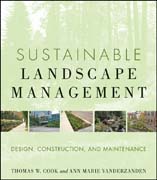
Sustainable landscape management: design, construction, and maintenance
VanDerZanden, Ann Marie
Cook, Thomas W.
The landscape industry is in the midst of major changes as the demand for environmentally responsible landscapes increases. This book offers a practical framework for the development of sustainable management strategies. Beginning with an overview of sustainable design and construction strategies, Sustainable Landscape Management focuses on key landscape management topics including ecosystem development, managing landscape beds, managing trees and shrubs, lawn care, and retro-fitting existing landscapes for sustainability, as it maps out asound plan promoting green initiatives INDICE: Preface. Acknowledgments. About the Authors. Chapter 1: Introduction to Sustainability. Introduction. Historical Perspective. Emergence of the Sustainable Movement. Olmsted and Vaux. Preservation vs. Conservation. Emergence of the Land Ethic. Post World War II. Our Common Future. Sustainable Landscapes. LEED. Sustainable Sites Initiative. Sustainable Maintenance. Green-washing. Summary. Study Questions. References Cited. Suggested Reading. Background. The Environmentalist Perspective. The Skeptic Perspective. Chapter 2: Sustainable Landscape Design. Introduction. The Process of Sustainable Landscape Design. Documenting Physical and Environmental Features of the Site. Starting the Landscape Design Process. Design Intent. Plant Selections to Increase Sustainability. Growing Environment. Creating Aesthetically Pleasing Landscapes. Creating Functional Landscapes. Designing Lawn Areas. Designing Planting Beds. Designing for Access and Circulation. Creating Landscapes that Meet Basic Human Physical and Cognitive Needs. Provide for Optimum Site Accessibility, Safety, andWayfinding. Provide Opportunities for Outdoor Physical Activity. Provide Views of Vegetation and Quiet Outdoor Spaces for Mental Restoration. Provide Outdoor Spaces for Social Interaction. Reduce Light Pollution. Designing to Minimize Maintenance. Designing to Minimize Maintenance Labor. Designing to Minimize Maintenance Products. Designing to Enhance a Landscapes Short- and Long-term Cost-Effectiveness. Short-Term Cost Effectiveness. Long-Term Cost Effectiveness. Integrating Specialized Design Approaches to Maximize Short- and Long-term Sustainability. Minimize or Eliminate Potable Water Consumption for Irrigation.Preserve and Restore Native Wildlife Habitat. Promote a Sense of Place with Native Vegetation and Appropriate Site Adapted Species. Manage Water On-site. Cleanse Water On-site. Summary. Study Questions. References Cited. Literature Reviewed. Additional Resources. Chapter 3: Sustainable Landscape Construction: Process, Irrigation Systems and Hardscape Materials. Introduction. The Conventional Landscape Construction Process. Rough Grading. Finish Grading. Cleanup. A Sustainable Landscape Construction Process Alternative. Control and Retain Construction Pollutants. Divert Construction and Demolition Materials from Disposal. Reuse or Recycle Vegetation, Rocks and Soil Generated during Construction. Preserving and Incorporating Existing Vegetation. Sustainable Irrigation Design and Installation Strategies. Irrigation Design. Irrigation Installation. Sustainable Hardscape Materials. Reduce, Reuse, Recycle. Environmental Impact after Installation. Maintenance Requirements. Sustainable Hardscape Products for Entrance Areas, Driveways, Walkways and Outdoor Seating Areas. Other Sustainable Hardscape Products. Summary. References Cited. Additional Resources. Chapter 4: Retro-fitting Existing Landscapes for Sustainability. Introduction. Site Analysis for Retrofitting. Does the Landscape Design Still Work Aesthetically?. Are there Landscape Maintenance Issues?. Are there Problems with Infrastructure Elements (Sidewalks, Driveways, Parking Areas, Lighting, Etc.). Are Lighting Elements Functioning at their Optimum Level?. Identifying Opportunities to Improve Landscape Sustainability. Eliminating Problem Areas. Improving Access and Circulation. Improving Maintenance Efficiencies. Improving Irrigation Effectiveness. Managing Water on Site. Summary. Study Questions. References Cited. Chapter 5: Ecosystem Development and Management in the Context of Sustainable Landscapes. Introduction. Sustainable Landscapes and Ecosystem Services. Historical Review of Ecological Design. How Landscapes Function as Ecosystems. Considerations in Designing a New Landscape Ecosystem. Designers Intent in Creating a Landscape Ecosystem. Plant Materials for Creating a Landscape Ecosystem. Establishment Strategies for a New Landscape Ecosystem. Management Strategies for a Landscape Ecosystem: Post Planting Succession, Plant Attrition due toChanging Microclimates, and Encroachment of Non-Planted Species. Post-Planting Succession. Plant Attrition due to Changing Microclimates. Encroachment of Non-planted Species. Summary. Study Questions. References Cited. Chapter 6 Environmental Issues. Introduction. Nutrient Leaching and Runoff. Phosphorus. Nitrogen. Pesticide Leaching and Runoff. Health Concerns Associated With Pesticides. Fish and Wildlife Issues Associated With Pesticides. Air Pollution Due to Power Equipment Emissions. Depletion of Water Resources. Sustainability and Environmental Rhetoric. Perspectives on Environmental Issues Regarding Pesticide Use. Summary. Study Questions. References Cited. Chapter 7: Sustainable Soils for Landscapes. Introduction. Healthy Soils. Biological Factors. Sustainable Options in Developing Soils for Landscapes. Fill Soils. On-site Soils. AmendingOn-site Soils. Importing, Manufacturing or Augmenting Landscape Soils. Managing Soils Sustainably. Mulch. Moisture, Compaction and Aeration. Summary. StudyQuestions. References Cited. Chapter 8: Managing Trees, Shrubs and Beds Sustainably. Introduction. Planting. Field Grown Bare Root Stock. Balled and Burlapped and Spade Dug Stock. Container Grown Stock. The Planting Hole. Other Amendments. Post Planting Care. Fertilization. Fertilizing transplants during establishment. Maintaining Long-Term Plant Health. Alleviating Nutrient Deficiencies. Assessing Fertilizer Needs. Irrigation. Irrigating New Plantings. Irrigating Mature Plantings. Reducing Irrigation in Landscape Beds. Improving Irrigation System Performance. Pruning. Pruning Shrubs and Groundcovers in Commercial Landscapes. Pruning Trees in Commercial Landscapes. Pruning Strategies for Young Trees. Pruning Strategies for Shrubs and Groundcovers. Problems Associated with Questionable Pruning Decisions. The Impact of Construction and Design Decisions on Pruning. General Pruning Strategies. Managing the Waste Stream. Managing Leaf Drop. Summary. Study Questions. References Cited. Chapter 9: Lawns inSustainable Landscapes. Introduction. Matching Grass Types to Climate in Theory and Practice. Impact of Grass Breeding Programs. Species for Sustainable Lawns. Cool Season Grasses for Sustainable Lawns. Warm Season Grasses for Sustainable Lawns. Other Commonly Planted Grasses. Grass and Dicot Species Combinations for Sustainable Lawns. Suitable Grass Plus Dicot Mixes. Sustainable Maintenance Strategies. Mowing Strategies. Irrigation Strategies. Fertilization Strategies. Summary. Study Questions. References Cited. Chapter 10 Sustainable Pest Management. Introduction. Defining IPM. The Components of IPM. Pre-construction Planning. Analysis of Existing Landscapes. Monitoring. Developing Action Thresholds. Selecting Resistant Plants. Insect Control strategies. Biological Insect Control Options. Control Options with Synthetic Insecticides. Disease Control Strategies. Weed Control Strategies. Weed Encroachment in Landscape Beds. Weed Control in Lawns. Summary. Study Questions. References Cited. Additional Reading.
- ISBN: 978-0-470-48093-9
- Editorial: John Wiley & Sons
- Encuadernacion: Cartoné
- Páginas: 272
- Fecha Publicación: 29/12/2010
- Nº Volúmenes: 1
- Idioma: Inglés
